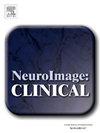在ad高危人群中,血脑屏障通透性因脑区域和APOE4状态而异,并与大脑微观结构相关
IF 3.4
2区 医学
Q2 NEUROIMAGING
引用次数: 0
摘要
背景:虽然有强有力的证据表明血脑屏障(BBB)在阿尔茨海默病(AD)中存在破坏,但其作用仍存在很大的不确定性。为了解决文献中的空白和不一致之处,我们研究了认知正常、AD风险较高的老年人血脑屏障通透性的区域差异、遗传风险的影响及其与淀粉样蛋白-β和性别的相互作用,以及血脑屏障破坏与大脑微观结构之间的关系。此外,我们比较了两种量化血脑屏障通透性的方法。方法对48例认知正常老年人进行动态磁共振增强成像和限制谱成像。我们研究了APOE4携带者和非携带者之间全脑区域血脑屏障通透性的差异,以及与大脑微观结构的关系。分析测试了APOE4与性别和淀粉样蛋白-β阳性的相互作用,并通过连续测量渗透性(Ktrans)和异常渗漏指数(ALI)进行比较。结果血脑屏障的通透性是可变的,在整个样本中,皮层灰质的通透性最高,包括额叶下、颞叶和一些感觉区域。与非携带者相比,APOE4携带者枕上、顶叶和额叶皮质区的通透性升高。在控制淀粉样蛋白-β阳性或使用ALI代替Ktrans后,结果没有变化。较高的通透性与改变的微观结构模式相关,APOE4携带者、淀粉样蛋白-β阳性个体和女性之间的关系最为密切。AD遗传风险较高的个体表现出与微结构异常相关的皮质血脑屏障通透性升高。这些关系在广泛的空间模式中被发现,这与AD神经病理学的典型传播不同。本文章由计算机程序翻译,如有差异,请以英文原文为准。
Blood-brain barrier permeability varies by brain region and APOE4 status and correlates with brain microstructure among high-AD risk groups
Background
Although strong evidence exists for blood–brain barrier (BBB) disruption in Alzheimer’s disease (AD), substantial uncertainty remains regarding its role. We address gaps and inconsistencies in the literature by examining regional variation in BBB permeability among cognitively normal older adults enriched for AD risk, the influence of genetic risk and its interactions with amyloid-β and sex, and the relationships between BBB breakdown and brain microstructure. Additionally, we compare two methods of quantifying BBB permeability.
Methods
Dynamic contrast-enhanced magnetic resonance imaging and restriction spectrum imaging were performed on 48 cognitively normal older adults. We examined differences in whole-brain regional BBB permeability between APOE4 carriers and non-carriers, as well as associations with brain microstructure. Analyses tested interactions of APOE4 with sex and amyloid-β positivity, and were compared using continuous measurements of permeability (Ktrans) and an abnormal leakage index (ALI).
Results
BBB permeability was variable, with highest values in cortical gray matter, including inferior frontal, temporal, and some sensory regions across the full sample. APOE4 carriers had elevated permeability throughout superior occipital, parietal, and frontal cortical regions compared to non-carriers. Results were unchanged after controlling for amyloid-β positivity or when using ALI instead of Ktrans. Higher permeability correlated with altered microstructural patterns, with the most robust relationships among APOE4 carriers, amyloid-β positive individuals, and women.
Discussion
Individuals at greater genetic risk for AD demonstrate elevated cortical BBB permeability associated with microstructural abnormalities. These relationships were seen in a widespread spatial pattern that is dissimilar from the stereotypical spread of AD neuropathology.
求助全文
通过发布文献求助,成功后即可免费获取论文全文。
去求助
来源期刊

Neuroimage-Clinical
NEUROIMAGING-
CiteScore
7.50
自引率
4.80%
发文量
368
审稿时长
52 days
期刊介绍:
NeuroImage: Clinical, a journal of diseases, disorders and syndromes involving the Nervous System, provides a vehicle for communicating important advances in the study of abnormal structure-function relationships of the human nervous system based on imaging.
The focus of NeuroImage: Clinical is on defining changes to the brain associated with primary neurologic and psychiatric diseases and disorders of the nervous system as well as behavioral syndromes and developmental conditions. The main criterion for judging papers is the extent of scientific advancement in the understanding of the pathophysiologic mechanisms of diseases and disorders, in identification of functional models that link clinical signs and symptoms with brain function and in the creation of image based tools applicable to a broad range of clinical needs including diagnosis, monitoring and tracking of illness, predicting therapeutic response and development of new treatments. Papers dealing with structure and function in animal models will also be considered if they reveal mechanisms that can be readily translated to human conditions.
 求助内容:
求助内容: 应助结果提醒方式:
应助结果提醒方式:


